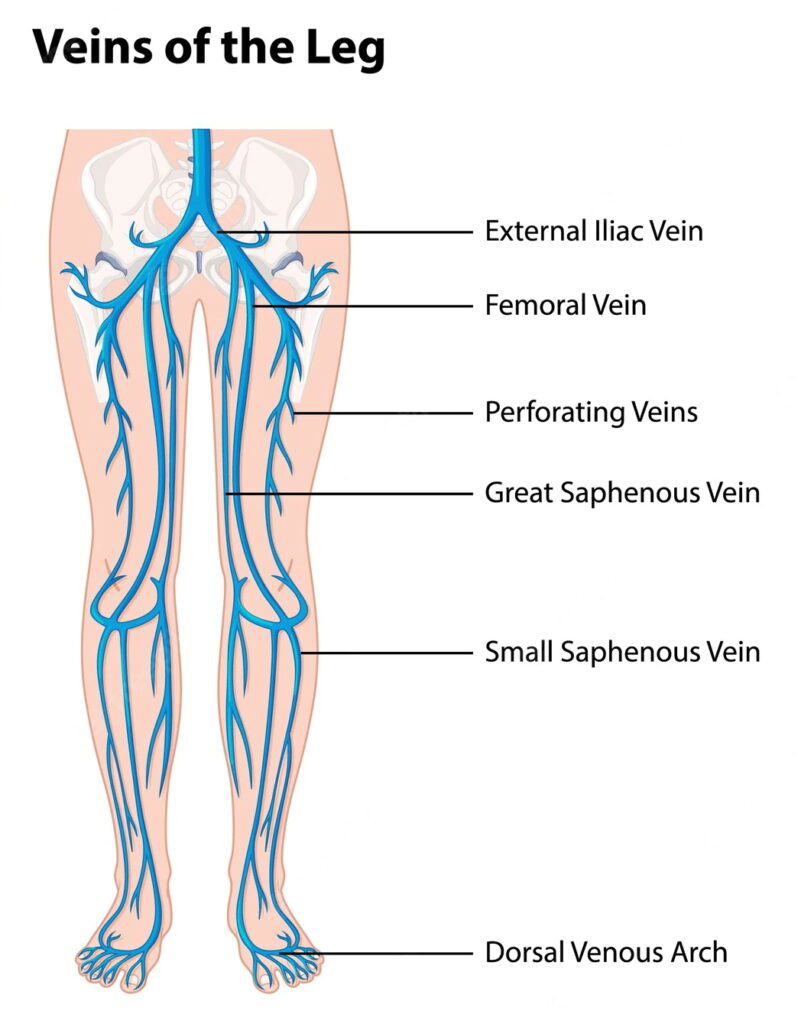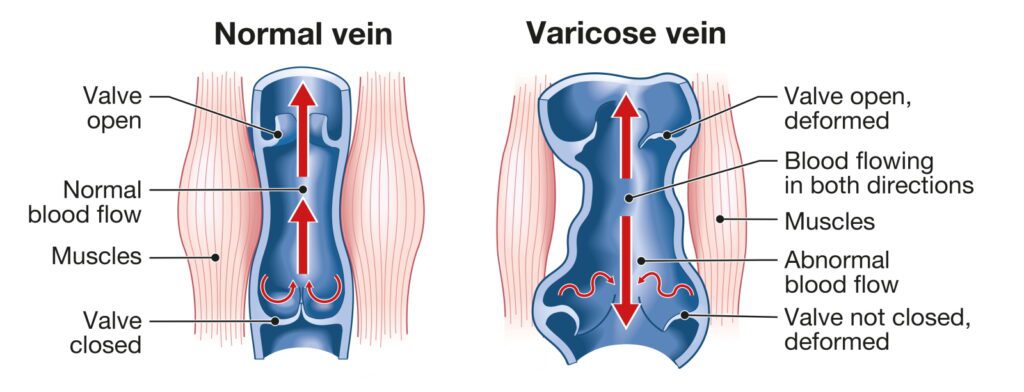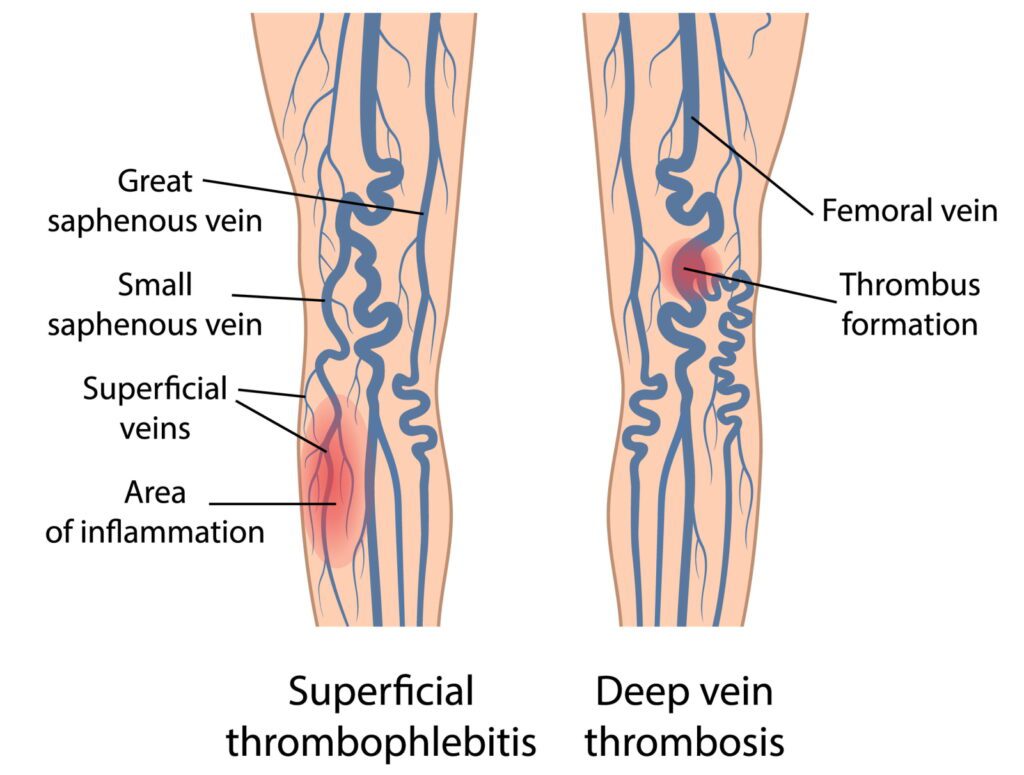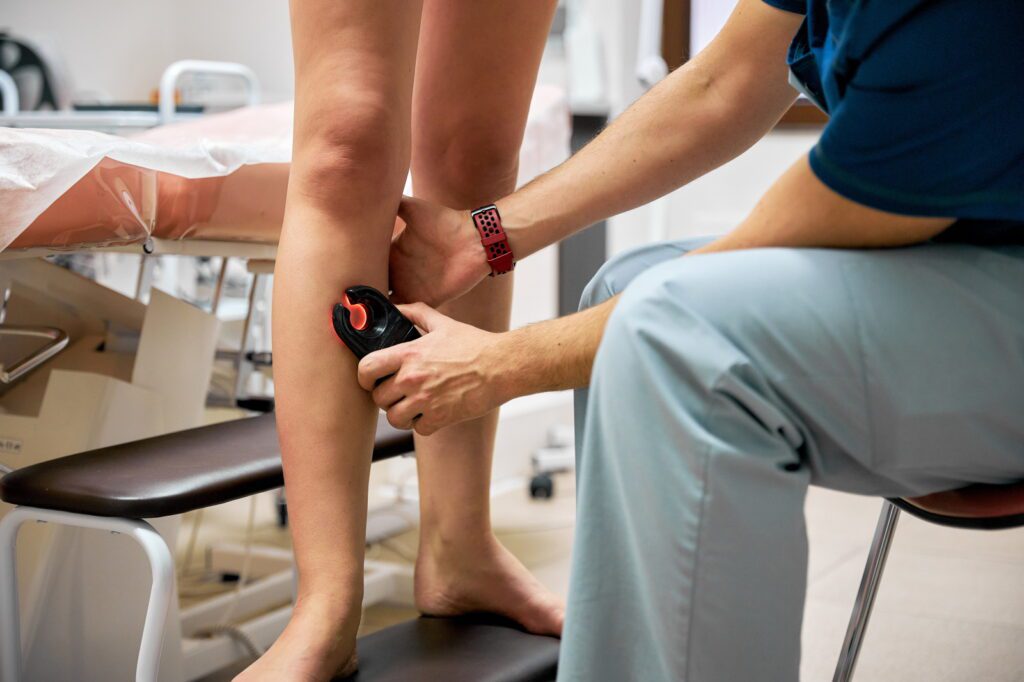Venous System Basics and How It Affects Your Leg Pain
Author: StrideCare Internal Team

A telltale sign that your veins are doing their job is that you never have to think about them. They keep blood moving throughout your body and support critical functions. As a result, you spend each day living your best life. But the reality is that veins are one piece of a much larger and more complex vascular system. And the instant this critical network struggles to work as it should, you can experience symptoms like leg pain, swelling, numbness, foot pain, ulcers, and other health concerns.
At StrideCare, our team of board-certified vein doctors constantly stress to our valued patients the importance of recognizing the signs of vein disease—even in its earliest stages. Part of that is understanding venous system basics and how it can affect your leg pain.
Are You Suffering from These Symptoms?
- Tired and heavy legs
- Swollen legs and feet
- Unsightly varicose veins
- Throbbing, achiness, or stabbing pain
- Cramping legs
- Itchy spider veins
- Numbness and tingling
- Prickling, pulling sensations
- Burning sensations
- Leg skin ulcers
Can Vein Problems Cause Leg Pain?
When you suffer from leg pain, it’s about all you can think about. Your legs are uncomfortable when you move, and they can even cause problems while you are at rest. You certainly can’t do all the things you used to love doing, and all you want is relief. For some people, the root cause is a vein issue, part of your overall venous system.
How Your Venous System Works
According to the Cleveland Clinic, the venous system is your network of veins. Veins are a type of blood vessel which return deoxygenated blood from your organs back to your heart. Your veins connect with other vessels that bring blood to organs throughout your body. Here’s how it works.
- Your blood enters tiny veins called venules before being passed to two central veins that deliver blood to your heart.
- One main vein, the superior vena cava, carries blood from your head and arms (the upper body) to the heart.
- Another main vein, the inferior vena cava, brings blood up from the stomach, pelvis, and legs (the lower body) to the heart.
- Veins in the lower extremities, like your legs, have valves to keep blood from flowing backward.
Arteries are also blood vessels but different from veins. Arteries deliver oxygenated blood from your heart to the rest of your body.
Think of this process like a large garden hose. When the hose is open and working, water flows freely. If there is a kink at any point in the hose, water cannot flow freely. The same can be said for your venous system. If any of your vein valves become faulty, the result is poor blood flow resulting in some of the issues described below.

Vein Types in the Venous System
Most veins are systemic. Systemic veins carry deoxygenated blood from the rest of the body back to your heart, where it then enters the pulmonary circuit for oxygen. Pulmonary veins carry deoxygenated blood from your heart to your lungs. Once your lungs oxygenate the blood, pulmonary vessels bring blood back to your heart.
Deep veins and superficial veins are two types of systemic veins:
- Deep veins – These veins are deep underneath the skin’s surface. They are larger than superficial venous veins and are encircled by muscle. Deep veins are responsible for returning most of your blood to your heart for usage and recycling by your body. Your lower body contains seven major deep veins. Because they are located farthest from your heart, they work the hardest to return blood to it.
- Superficial veins – The word “superficial” is a little deceptive. Superficial veins include those that are visible at the surface as well as those larger, more significant ones that are hidden beneath the skin and are invisible to the naked eye. When you exercise or move anything heavy, these veins are more likely to stick out than others. They serve an important role, moving the blood from your body’s tissues to the deep veins.
Of the superficial veins in the lower extremities, there are two main ones:
- Great Saphenous Vein (GSV) — Known as the largest vein in the body, the GSV starts in your foot and runs superficially along the length of the lower limb before connecting into the femoral vein. Your femoral vein is a large blood vessel in your thigh. The GSV drains deoxygenated blood from the foot, leg, and knee and carries it to the deep veins, where it can keep flowing back to your heart.
- Small Saphenous Vein (SSV) — The SSV runs up the back of the leg and drains the leg’s lateral surface around the knee. As a systemic vein, its purpose is similar to the GSV in that it carries deoxygenated blood to the deep veins and the heart.
Common Venous System Leg Pain Issues
The problem is that veins can age as we do and reach a point where they can’t do their job as efficiently as they once did. As a result, vain valves may malfunction, causing blood to flow backward in the wrong direction. This causes veins to bulge, stretch, and enlarge.
At first, there may not be any symptoms other than unsightly spider veins and varicose veins. But if left unchecked, uncomfortable leg pain can set in. An average of one in every three adults over the age of 45 develops some form of vein disease. Just a few of the more common examples of vein disease include:

Varicose Veins
Damaged veins that manifest as blue, twisted, and occasionally bulging veins are known as varicose veins. Varicose veins are common. Twenty five percent of American adults experience them at some point. Damaged valves that prevent your veins from doing their duty of sending blood back up to your heart are the root of this issue. Those one-way valves are essential to the veins’ healthy operation since your leg veins fight gravity all day long while attempting to pump that blood upward.
There is no way to tell the severity of your vein problem without consulting a vein specialist. Plus, varicose veins and superficial vein disease can lead to a wide range of issues, both on the skin’s surface and in your deep vein system.
Chronic Venous Insufficiency
The telltale signs of CVI include leg swelling, painful varicose veins, cramping legs, heavy or tired legs, leg skin discoloration, and open chronic leg wounds or ulcers that are difficult to heal on their own.
Restless Leg Syndrome
You know RLS as a pins and needles sensation in your legs. It can also manifest itself as leg tingling, prickling, and pulling sensations. Advanced stages impact a person’s ability to sleep.
Superficial Thrombophlebitis
Blood clots, referred to as superficial thrombophlebitis, are one of the most prevalent vein disorders in superficial veins. The harm posed by these clots is lower than that from blood clots in deep veins, however they should nevertheless not be overlooked. These must be examined because they may evolve into or increase your chance of acquiring a deep vein blood clot.
Deep Vein Thrombosis
Blood clots in a deep leg vein are highly concerning because you no longer experience the occasional pain in your legs. You are dealing with a situation that is potentially fatal. A deep blood clot, or deep vein thrombophlebitis (DVT), is like superficial thrombophlebitis. However, DVT can induce pulmonary embolism, making it a much more serious blood clot than a superficial one. When a deep blood clot leaves a damaged leg vein and goes to the lung, the condition is known as pulmonary embolism and can be fatal. Visit a vein specialist as soon as possible if you suspect that you may have DVT.

What Is the Best Treatment for Leg Pain from Venous Issues?
Vascular specialists like the team here at StrideCare are committed to diagnosing and treating the root cause of your leg pain rather than focusing solely on symptoms. When the root cause is addressed, patients typically find they are not in as much discomfort and can go on to lead normal lives.
Minimally invasive treatment options exist to get the leg pain relief you’ve been looking for. This includes:
Sclerotherapy — Specialists inject a small amount of a specially formulated chemical solution full of sclerosing agents into the affected veins to reduce pain and discomfort caused by the enlargement or swelling of the veins. This solution irritates the vein walls and causes the vein to collapse and disappear.
Microfoam ablation — With this procedure, your specialist injects a special microfoam into your affected veins to relieve symptoms without the use of heat or tumescent. The foam fills the desired section of the vein, and the diseased vein collapses. Blood flow then shifts to healthier veins nearby.
Radiofrequency ablation — A thin catheter is inserted into the diseased vein through a small puncture. The catheter is guided up into the great saphenous vein in the thigh or the small saphenous vein in the calf. The radiofrequency energy is delivered to the inside of the vein, which cuts off blood flow and relieves symptoms.

Stop Venous Leg Pain Now by Calling StrideCare
Do you have chronic leg pain? Are you worried that your symptoms could be a sign of more serious health conditions related to vein disease? Call us! It’s important to recognize vein disease in its earliest stages and seek help from a medical professional who can guide you on your next steps.
If you’re doing all the right things and still aren’t finding relief, we can help.
StrideCare has long been a leader in performing leading-edge procedures to treat vein disease. This includes varicose veins, spider veins, edema/leg swelling, leg skin ulcers, restless leg syndrome, blood clots, and more—all the while providing compassionate patient care.
StrideCare physicians are board-certified diagnostic radiologists with additional fellowship training in vascular and interventional radiology. If your veins need treatment—or you have questions on how to avoid the onset of venous disease—the experts at StrideCare will recommend an individualized plan to help you get the best results. Request an appointment for a vein disease evaluation to discuss your options.
Prior to starting any new treatment or questions regarding a medical condition, always seek the advice of your doctor or other qualified health provider. This information is not a substitute for professional medical advice.
StrideCare serves the South Texas area including Houston, San Antonio, Austin, Round Rock, Bastrop, Brushy Creek, Cedar Park, Converse, Georgetown, Hutto, Kyle, Leander, Marble Falls, New Braunfels, Pasadena, Pearland, Pflugerville, San Marcos, Schertz, Houston, Sugar Land, Katy, Webster, Bay City, Clear Lake, Lake Jackson, The Woodlands, Universal City, Spring, Kingwood, Stafford, Conroe, Texas City, Cypress, League City, Bellaire, and more.


